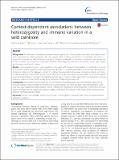Files in this item
Context-dependent associations between heterozygosity and immune variation in a wild carnivore Evolutionary ecology and behaviour
Item metadata
| dc.contributor.author | Brock, P.M. | |
| dc.contributor.author | Goodman, S.J. | |
| dc.contributor.author | Hall, Ailsa Jane | |
| dc.contributor.author | Cruz, M. | |
| dc.contributor.author | Acevedo-Whitehouse, K. | |
| dc.date.accessioned | 2015-11-24T17:40:02Z | |
| dc.date.available | 2015-11-24T17:40:02Z | |
| dc.date.issued | 2015-11-04 | |
| dc.identifier | 234010997 | |
| dc.identifier | d943fe37-4eb7-4e9c-a361-f8a674af2e59 | |
| dc.identifier | 84946123463 | |
| dc.identifier | 000364184300003 | |
| dc.identifier.citation | Brock , P M , Goodman , S J , Hall , A J , Cruz , M & Acevedo-Whitehouse , K 2015 , ' Context-dependent associations between heterozygosity and immune variation in a wild carnivore Evolutionary ecology and behaviour ' , BMC Evolutionary Biology , vol. 15 , no. 1 . https://doi.org/10.1186/s12862-015-0519-6 | en |
| dc.identifier.issn | 1471-2148 | |
| dc.identifier.other | ORCID: /0000-0002-7562-1771/work/47136300 | |
| dc.identifier.uri | https://hdl.handle.net/10023/7843 | |
| dc.description.abstract | Background: A multitude of correlations between heterozygosity and fitness proxies associated with disease have been reported from wild populations, but the genetic basis of these associations is unresolved. We used a longitudinal dataset on wild Galapagos sea lions (Zalophus wollebaeki) to develop a relatively new perspective on this problem, by testing for associations between heterozygosity and immune variation across age classes and between ecological contexts. Results: Homozygosity by locus was negatively correlated with serum immunoglobulin G production in pups (0-3 months of age), suggesting that reduced genetic diversity has a detrimental influence on the early development of immune defence in the Galapagos sea lion. In addition, homozygosity by locus was positively correlated with total circulating leukocyte concentration in juveniles (6-24 months of age), but only in a colony subject to the anthropogenic environmental impacts of development, pollution and introduced species, which suggests that reduced genetic diversity influences mature immune system activity in circumstances of high antigen exposure. Conclusions: These findings demonstrate the environmental context-dependency of the phenotypic expression of immune variation, which is implicit in the theory of ecoimmunology, but which has been rarely demonstrated in the wild. They also indicate that heterozygosity may be linked to the maintenance of heterogeneity in mammalian immune system development and response to infection, adding to the body of evidence on the nature of the mechanistic link between heterozygosity and fitness. | |
| dc.format.extent | 500481 | |
| dc.language.iso | eng | |
| dc.relation.ispartof | BMC Evolutionary Biology | en |
| dc.subject | QH301 Biology | en |
| dc.subject.lcc | QH301 | en |
| dc.title | Context-dependent associations between heterozygosity and immune variation in a wild carnivore Evolutionary ecology and behaviour | en |
| dc.type | Journal article | en |
| dc.contributor.sponsor | NERC | en |
| dc.contributor.institution | University of St Andrews. University of St Andrews | en |
| dc.contributor.institution | University of St Andrews. School of Biology | en |
| dc.contributor.institution | University of St Andrews. Sea Mammal Research Unit | en |
| dc.contributor.institution | University of St Andrews. Marine Alliance for Science & Technology Scotland | en |
| dc.contributor.institution | University of St Andrews. Scottish Oceans Institute | en |
| dc.identifier.doi | 10.1186/s12862-015-0519-6 | |
| dc.description.status | Peer reviewed | en |
| dc.identifier.url | http://www.biomedcentral.com/1471-2148/15/242/additional | en |
| dc.identifier.grantnumber | Agreement R8-H12-86 | en |
This item appears in the following Collection(s)
Items in the St Andrews Research Repository are protected by copyright, with all rights reserved, unless otherwise indicated.

